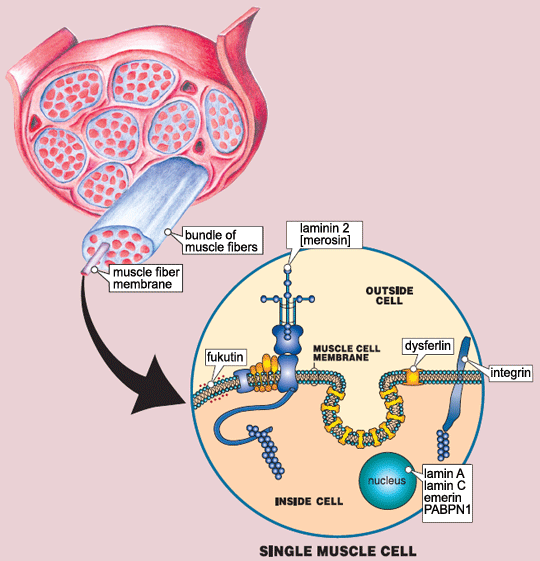Emery-Dreifuss Muscular Dystrophy (EDMD)
Causes / Inheritance
What causes EDMD?
Researchers recently have identified the genes that, when defective, lead to the forms of EDMD. We now know that the gene that’s defective in X-linked EDMD makes a  small protein called emerin, which normally is located in the membrane that surrounds each cell’s nucleus (the compartment in a cell’s center that contains the chromosomes).
small protein called emerin, which normally is located in the membrane that surrounds each cell’s nucleus (the compartment in a cell’s center that contains the chromosomes).
It isn’t yet understood how the loss of emerin from the nuclear membrane in X-linked EDMD leads to the symptoms of muscular dystrophy. Some researchers think this lack of emerin interferes with the reorganization of the nuclear membrane after a cell has divided, leading to weak or dying cells. Along these same lines, the gene that’s been found defective in both the autosomal and recessive forms of EDMD contains the instructions for two closely related proteins called lamin A and lamin C that also are associated with the nuclear membrane of cells.
Again, it isn’t yet known how changes in lamins A and C lead to the symptoms of muscular dystrophy, but some research suggests that the nuclear membrane may become destabilized when the lamin proteins are abnormal. This could lead to muscle breakdown.
Another question that remains to be answered is why the symptoms of EDMD are restricted primarily to the skeletal (voluntary) muscles and heart muscle, given that the emerin and lamin proteins are found in most tissues of the body.
How is EDMD inherited?
EDMD is most commonly inherited through an X-linked, recessive pattern that primarily affects males, who inherit the disease from their mothers. Another type is autosomal dominant, meaning it can be inherited through either parent. A third, very rare type is autosomal recessive, when a faulty gene is inherited from each parent. All forms have similar symptoms. For more on inheritance patterns in neuromuscular disease, see Facts About Genetics and Neuromuscular Diseases.

